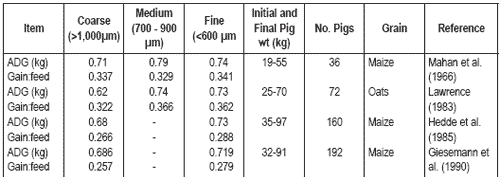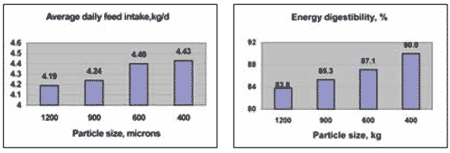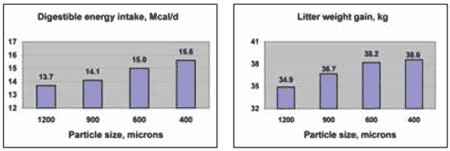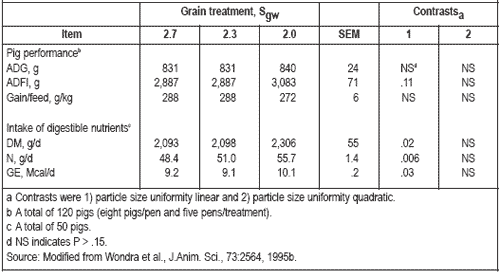animal feed and processing method
Improved animal performance through feed processing technology (Part 1)
It is well recognized that feed represents the most significant cost of animal production. Even with sheep, which typically consume more forage (as a percentage of their diet) than do other domestic species, feed may represent 55% or more of total production costs.
For poultry at least 70% of the production costs estimates are feed costs. In today’s industry, few producers or nutritionists would consider feeding animals without giving detail attention to energy and amino acid concentrations and ratios, and to optimum mineral and vitamin supplementation. Nutritionists now know, with precision, the biological value of feed ingredients and the nutrient requirements of different species. In addition, geneticists have improved the growth rate, body size, yield, etc. to levels once thought unattainable.
However, even though it is well recognized that high quality manufactured feed will directly impact growth and feed conversion, the importance of feed quality is given not enough priority. Where producers of animal/poultry products no longer purchase feed from feed mills, the emphasis on feed quality, a task originally undertaken by independent feed mills, has declined, as the feed is made “in-house”.
In poultry, the risk associated with pathogens passing from feed to growing birds is small but does exist. This is a risk factor that has the potential to be extremely costly and should also be addressed by current feed manufacturing practices. Clearly, we have ways to improve the hygienic quality of feed using different types of manufacturing methods, however, we must be willing to absorb additional feed manufacturing costs as well as make basic changes in the way feed is processed, handled, and transferred to the farm.
Selection of reasonable priced, good quality ingredients and proper processing of those ingredients into complete diets is equally important to the overall profitability of the producer. Although feed processing is often given little emphasis, it represents a significant portion of feed costs and likely gives the greatest opportunity for influencing animal performance beyond nutritional adequacy.
“Feed processing” and the costs associated with processing include a wide range of unit operations including receiving, grinding, proportioning, mixing, pelleting, load out, and delivery. Nearly every one of these operations can have either a negative or positive influence on subsequent animal performance and can certainly influence final profitability. Of the above-mentioned unit operations, grinding, mixing, and pelleting are likely to have the greatest influence on animal performance and feed quality and are dealt with, at least to some extent, in the scientific literature.
Grinding of Feedstuffs
Grinding is a major function of feed manufacturing and is by far the most common method of feed processing. It is also the most cheapest and simple process and results in a substantial reduction in particle size and exposure of much more surface area to action of chemicals as well as to the digestive juices. The grinding of ingredients generally improves feed digestibility, acceptability, mixing properties, increases the bulk density of some ingredients, and facilitates further processes such as extrusion and pelleting. Reimer (1992) indicated that fineness of grind may control 20% of a pellet’s quality.
Decreasing particle size from a coarse to a fine grind exposes more surface area per unit volume for absorption of condensing steam during the conditioning process. This results in a higher feed temperature and more water absorption, which together, within the time available, increases gelatinization of raw starch.
Starch gelatinization is the rupture of starch granules, thereby allowing the linear and cyclic molecules to hydrate and become sticky in the presence of water. Grinding can also improve pellet quality by reducing air spaces between particles, allowing closer surface to surface contact for a given volume of feed; i.e., it increases bulk density. Large pieces of any ingredient in a feed formula result in weak spots in the pellet, especially if these are fibrous or bony.
Some earlier research (MacBain, 1966) also indicated that a variation in particle size produces a better pellet than a homogenous particle size. In contrast, other studies (Stevens, 1987) found no effect of particle size on pellet durability index. Ideally, the cost of grinding energy in achieving optimum particle size for ideal pellet durability should be determined in each feed mill separately and should be weighed against pellet quality (and therefore animal performance improvement) expectations.
Grinding is accomplished by many types of manual and mechanical operations involving impact, attrition, and cutting. Of the various mill designs that can be used to grind feedstuffs, hammer mills and roller mills are by far the most commonly used in the production of animal feeds.
With a hammer mill the kernel is shattered into small enough pieces that it can escape from the mill by passing through a screen. Particle size is primarily controlled by size of the holes in the screen. With roller mills grinding results from crushing, cutting, and shearing as the kernels are pulled between the rolls. Adjusting the gap between the rolls controls particle size with roller mills.
Various pig researchers, studying the effect of mean particle size reduction of several grains, in general observed positive responses on growing pig performance when fine ground ingredients were compared to more coarsely ground material (Table 1).
| Table 1:Effect of particle size reduction on growth performance of pigs. |
  |
  |
| Figure 1:Effects of maize particle size on lactation performance of primiparous sows and apparent digestibility and intake of energy (Wondra et al., J Anim. Sci., 73:421, 1995d). |
Hedde et al. (1985) reported an increase in ADG of 8% for finishing pigs fed maize-based diets when the particle size was reduced from a coarse grind (<20% of the ground grain passing through a 1.2-mm screen) to a fine grind (>80% of the ground grain passing through a 1.2- mm screen). Goodband and Hines (1988) reported a 5% increase in rate of gain for starter pigs fed a barley-wheat based diet when the barley was ground to a mean particle size of 635μm compared to 768μm. Similarly, Lawrence (1983) observed a 12% improvement in gain: feed when the particle size of oats was decreased from >1000μm to <600μm.
More recently Mavromichalis et al. (1998) reported 10 and 9% improvements in rate and efficiency of gain in nursery pigs as the particle size of wheat was decreased from 1300 to 600 to 400μm. Cabrera et al. (1994) observed a 7 and 6% increase in softand hard-endosperm sorghum when particle size was reduced from 800 to 400μm, which is in agreement with the improved efficiency of gain for nursery pigs that Gieseman et al. (1990) reported when the particle size of maize and bronze sorghum was reduced from 1300 to 600μm. Wondra et al. (1995a) studied the effect of a wider range of particle sizes in maize (ranging from 1000 to 400μm) and observed a 1.3% increase in gain: feed for every 100μm reduction in particle size of the maize.
For growing pigs, the literature in general suggests a 1.2 to 1.4% improvement in gain: feed for each 100-μm decrease in mean particle size of maize as an appropriate “rule of thumb” value. Fine grinding has, however, also been implicated in the development of ulcers in the oesophageal region of pigs (Mahan et al., 1966; Reimann et al., 1968; Hedde et al., 1985). This is still an area of investigation.
| Table 2:Effect of maize particle size on nutrient metabolism in second-parity sows during lactationa. |
 |
| Table 3:Effects of particle size uniformity on growth performance and intake of digestible nutrients in finishing pigs. |
 |
| Table 4:Effects of mill type and particle size on growth performance and apparent digestibility, intake, and excretion of nutrients in finishing pigs. |
 |
Unfortunately, very few experiments exist that determine the effects of feed processing on performance of lactating sows. Traditional dietary regimens often do not meet the nutrient requirements of high-producing sows. Nutrient intake of sows is often increased by increasing nutrient density (protein and/or fat), however, this also increases diet costs. Little attention has surprisingly been given to the possibility of increasing digestibility of the nutrients already in the diet.
Wondra et al. (1995d) fed 100 primiparous sows diets with maize milled to four particle sizes (1200, 900, 600, 400μm). Feed intake and digestibility of nutrients decreased (Figure 1) as particle size of maize was reduced from 1200 to 400μm. This also resulted in a marked increase of 14% greater intake of digestible energy (DE) and an 11% improvement in litter weight gain.
In another study, Wondra et al. (1995c) fed 38 second-parity sows maizesoybean meal-based diets during lactation. Their study was specifically aimed to determine the improvement in nutrient digestibility when the particle size of maize was ground to 1200, 900, 600 and 400μm. The results reported indicate greater digestibility of DM, N, and gross energy as the particle size of maize in the diet was reduced from 1200 to 400μm (Table 2).
Digestible energy and ME values were maximized with the diet having 400-μm maize. The ME concentration was indeed increased from 3399 to 3745 kcal/kg as particle size was reduced from 1200 to 400μm. In practice, to achieve the same increase in energy density with diet formulation methods, a 9% addition of soybean oil would be needed.
From the data reported above and other earlier research (Sauer et al., 1977; Owsley et al., 1981) that specifically addressed the effect of reduced particle size on nutrient digestibility, it is evident that the improved performance of growing pigs and lactating sows in response to grinding ingredients results largely from greater nutrient digestibility.
As for effects of roller mills and hammer mills on growth performance of e.g. pigs, some also suggest that the more uniform particle size (i.e., lower standard deviation, or Sgw of the mean particle size) achieved with roller-mill grinding has nutritional significance.
Wondra et al. (1995b) studied the effects of particle size uniformity and milling with a hammer mill or roller mill on growth and other performance characteristics in finishing pigs (Table 3). The treatments in their study were: (1) a blend of coarsely rolled and finely ground maize with a large Sgw of 2.7; (2) hammer milled maize with a Sgw of 2.3; and (3) roller milled maize with a Sgw of 2.0. Mean particle size of the maize was similar for all three treatments.
Decreasing Sgw increased the intake of digestible DM, N, and GE but did not affect growth performance significantly.
In a second experiment, the authors fed maize ground in a hammer mill or roller mill to 800 or 400μm (Table 4). Maize ground in the hammer mill had Sgw of 2.5 and 1.7, and maize ground in the roller mill had Sgw of 2.0 and 1.9 at 800 and 400 μm, respectively.
From this experiment, pigs fed maize ground to 800μm in the roller mill had greater digestibility of nutrients than pigs fed maize ground to 800μm in the hammer mill. Digestibility was also greater when maize was milled to 400μm in the roller mill even though the hammer milled maize had a slightly lower Sgw. This suggested a mill-type effect separate from the Sgw effect.
Reece et al. (1985) described particles of hammer milled maize as more spherical in shape with more uniform edges than particles of roller-milled maize. The spherical shape would reduce susceptibility to attack by enzymes, thus, decreasing digestibility of nutrients in hammer milled maize. This explanation is difficult to verify, but the possibility of particle shape affecting nutritional value of cereals is intriguing.
Thus, increased particle size uniformity (i.e., using a roller mill) may improve digestibility of nutrients in pigs, but this effect does not seem to be accompanied by predictable improvements in growth performance. Therefore, the industry has focused attention on the consistent improvements in performance that accompany decreased mean particle size rather than the subtle changes associated with greater uniformity of particle size. Because of the focus on reducing mean particle size with as much ease as possible, the hammer mill continues to be the favourite grinding system used for manufacturing feeds.
In poultry diets the effects of diet particle size appear to be confounded with complexity of the diet as well as further processing such as pelleting or crumbling. Cabrera (1994) found no effect of diet particle size (1000 to 400μm) on growth performance of broiler chicks fed a complex diet fed in crumble form. In a second study, feed efficiency was improved 3% by reducing particle size from 1000 to 500μm in simple diets fed as meal form but not in crumbled form. Therefore the response to reduced particle size (500 to 600μm) in broiler chicks appears to be the greatest when fed simple (grain-soybean meal) diets in a meal form. Feeding a complex diet in a crumbled form did not appear to require particle size below 1000μm.
Studies with laying hens suggest no advantages in reducing particle size below 800μm.
From the above, it can be concluded that the evaluation of the effect of grind fineness on animal performance continues to be an active area of research. Much needs to be learned regarding other cereals as well as protein meals in this regard.
Author: Dr Hinner Köster
Afgri Animal Feeds
 | The previous article is a special collaboration from AFMA South Africa |








.jpg&w=3840&q=75)